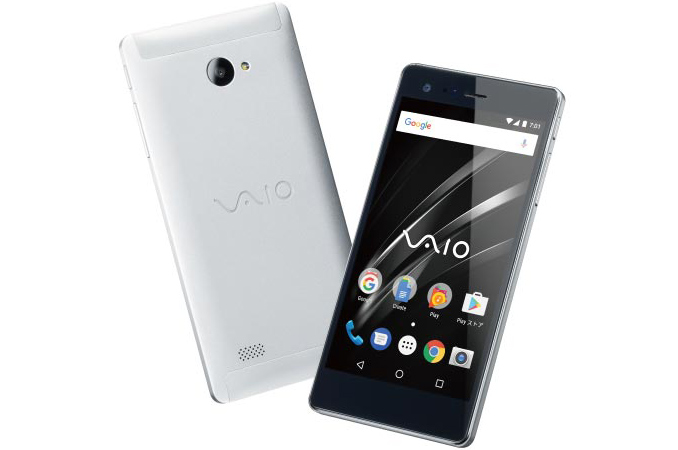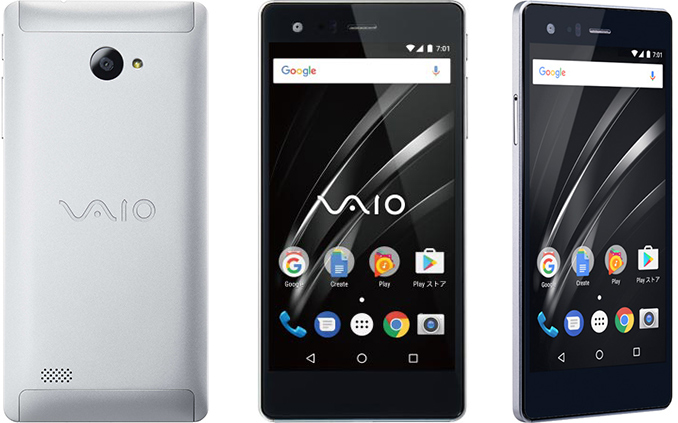VAIO Launches Phone A: Snapdragon 617, 3 GB RAM, 5.5” FHD, Android
by Anton Shilov on May 6, 2017 3:00 PM EST- Posted in
- Smartphones
- Android
- VAIO

VAIO has launched its new Google Android-based smartphone in Japan. The VAIO Phone A handset uses the same hardware platform as the company’s VAIO Phone Biz launched last year, but uses Google's more popular operating system. VAIO is selling the Cortex-A53 based mid-range phone for less than $250, which is very low for a phone made of machined aluminum.
VAIO, the former PC division of Sony and now an independent PC vendor from Japan, entered the smartphone market with its VAIO Phone Biz handset about a year ago targeting primarily business users. Since VAIO’s PCs run Windows 10, it was logical for the company to launch a Windows 10 Mobile-based handset supporting the Continuum technology and all the features that Microsoft’s platform has to offer. Apart from the OS, the key selling point of the VAIO Phone Biz was its aluminum unibody, which promised to be very durable. VAIO has never commented on just how well the Phone Biz has sold over its lifetime, but a year after the release of the product VAIO is re-launching it with Google Android.
Just like VAIO’s first smartphone, the Phone A (VPA 0511 S) is powered by the Qualcomm Snapdragon 617 system-on-chip (eight ARM Cortex-A53 cores clocked at 1.50 GHz, Adreno 405 graphics core) and features a 5.5” FHD display. The handset comes equipped with 3 GB of LPDDR3 memory, 16 GB of NAND flash storage (and a microSD card slot for expansion), 13 MP rear and 5 MP front cameras, 802.11a/b/g/n/ac Wi-Fi, Bluetooth 4.0, a micro USB 2.0 connector, various sensors, a 2800 mAh battery, and so on. Just like its Windows 10-based brother, the new unit also supports two SIM cards (a nano SIM and a micro SIM) and is compatible with 3G/LTE bands 1, 3, 6, 8, 11, 19 and 21 with carrier aggregation (so, not suitable for the U.S.). Finally, the weight and thickness of the product remained the same as before: 8.3 mm and 167 grams.
Despite the fact that the Snapdragon 617 is supported by Android 7, VAIO ships its Phone A with vanilla Android 6.0. It is unknown whether the company plans to update the OS eventually, but right now, the handset looks a bit outdated in terms of both hardware and software.
Computers and phones supplied by VAIO are developed by the company’s engineers and are made by various contract manufacturers. Meanwhile, the final quality checks and assembly of the hardware is performed at the Nagano Technology Site (Azumino City, Nagano Prefecture), the former hub of Sony’s PC operations. Due to that and materials used, VAIO has a reason to claim that its products feature a higher quality than competing offerings from its rivals, which is especially true when it comes to inexpensive Android handsets.
The VAIO Phone A is now available from the company’s online store exclusively in Japan; though like the Phone Biz, this phone is likely to show make its way to foreign third-party retailers as well. The company charges ¥26,784 ($237) per unit, which is uncommonly cheap for a smartphone featuring a durable, machined aluminum unibody, even taking the hardware and software into consideration. On the other hand, given the cutthroat competition on the Android market, a low price point is a way to drive sales.
Sources: VAIO, K-Tai Watch.
Related Reading:












36 Comments
View All Comments
Death666Angel - Saturday, May 6, 2017 - link
Cortex A53 smartphones are becoming quite boring.vladx - Saturday, May 6, 2017 - link
Well it's a low-end phone and I guess VAIO bets on its name selling well, otherwise there are better devices at this price point.Meteor2 - Monday, May 8, 2017 - link
One wonders if they will ever die.UtilityMax - Monday, May 8, 2017 - link
The thing I am wondering about is when the SoCs built A53 cores on _28nm_ process will finally die. Not all A53 cores are "bad" or "outdated". For example, the Snapdragon 625 used in a number of Moto smartphones is using A53 cores built on 14nm process. These phones have performance comparable to the Snapdragon 800 SoCs while having very modest impact on the battery. This is what should be the low-end SoC today. Instead we're being offered 2015 SoC is the low-end SoC in 2017. This is a joke.hybrid2d4x4 - Wednesday, May 10, 2017 - link
This is exactly how I approached looking for a phone late last year. I got the Redmi 4 Prime with the 625 chipset and it's ok for my needs. 3-5 days of battery life is nice. 28nm was an immediate show-stopper for me at the end of 2016, and it's a disgrace that it's still available for sale in a new phone today.That said, I feel like anything other than the high-end of SoCs is garbage conceptually, if not always in practice. Why anyone would want 8 slow cores is beyond me. I think the SD820/821 setup is what the mid-range should've been (2fast+2slow cores), with a 1 fast+1or2 slow cores for the low-end. It just sucks when your only options are flagship vs. garbage in SoCs.
helvete - Thursday, July 20, 2017 - link
A53 should be enough for everyone!Lehti - Saturday, May 6, 2017 - link
This actually looks rather nice. I have to admit I came in thinking "Oh, awesome, they're trying to squeeze every bit of sales they can out of Sony's former brand", but at that price, it's hard to fault this phone.Marlin1975 - Saturday, May 6, 2017 - link
$237 for a 617 based phone, that's to much. You can get a Moto G4 with a 617 for less. Or the Moto G5 Plus with the 625 for about the same price.SquarePeg - Saturday, May 6, 2017 - link
The Moto G4 Plus is $174.99 at Best Buy and the G5 Plus is $229 everywhere. I put zero value on a metal shell on a budget smartphone. The money would have been better spent on upgrading to the SD 625.Meteor2 - Monday, May 8, 2017 - link
The G4 is out of production and the G5 uses a slower processor(!). At least the 625 in the bigger phone is as good as A53-based SoCs get.